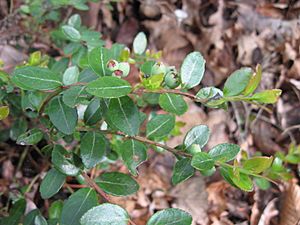Box huckleberry facts for kids
Quick facts for kids Box huckleberry |
|
|---|---|
 |
|
| Box huckleberry in fruit | |
| Conservation status | |
| Scientific classification | |
| Genus: |
Gaylussacia
|
| Species: |
brachycera
|
| Synonyms | |
|
|
The Gaylussacia brachycera, often called box huckleberry, is a small North American shrub. It is a close relative of the blueberry and other huckleberries. This plant grows naturally in the east-central United States. You can find it in states like Pennsylvania, Delaware, Maryland, Virginia, West Virginia, North Carolina, Kentucky, and Tennessee.
Box huckleberry is special because of its leaves. They look a lot like the leaves of a boxwood plant, which is how it got its name. Unlike other huckleberries, its leaves don't have sticky resin glands. In early summer, it grows white, bell-shaped flowers. These flowers turn into blue, tasty berries by late summer. Many of these plants are found in the Appalachian Mountains. Local people knew about and ate these berries long before scientists discovered them in the 1920s.
This plant is a relict species, meaning it's a survivor from a very long time ago. It almost disappeared during the last ice age. Box huckleberry cannot reproduce by itself using seeds. Instead, it grows in separate groups, or "colonies," that spread by sending out roots. This creates clones of the original plant. One colony in Pennsylvania might be as old as 8,000 years! This would make it the oldest woody plant east of the Rocky Mountains. Another colony in Pennsylvania, about 1,300 years old, is now protected in the Hoverter and Sholl Box Huckleberry Natural Area.
Contents
What Does It Look Like?
The box huckleberry is a short shrub, usually about 6 to 8 inches (15 to 20 cm) tall. Its leaves are shiny and oval-shaped, about 1 inch (2.5 cm) long. They have tiny teeth along their edges and turn red in winter. These evergreen leaves are quite different from other Gaylussacia species because they don't have sticky glands.
The plant flowers in May and June. Its flowers are white and shaped like small urns, sometimes with a pink tint. Like other huckleberries, the flowers grow in clusters from where the leaves meet the stem. The fruits appear in July and August. These are blue berries that grow on short stems.
Where Does It Grow?
Scientists have found about 100 different places where box huckleberry grows. For a while, the only known colony was in Pennsylvania, discovered in 1845. Later, more plants were found in Delaware in 1870.
In 1919, a scientist named Frederick V. Coville worried that the plant was in danger. He found that the large colony in Pennsylvania was all connected by roots. This meant it was one giant plant spreading underground. He also saw no new seedlings growing from seeds. This led him to believe that the plant couldn't reproduce by itself with seeds. After some plants were removed from the Pennsylvania site, Coville worked hard to protect the species. This site is now the Hoverter and Sholl Box Huckleberry Natural Area.
This news made many people interested in the plant. Soon, more colonies were found in Pennsylvania, Delaware, Maryland, Virginia, Tennessee, Kentucky, and West Virginia. Many of these places were already known to local people. They picked the berries for food, calling them "juniper-berry" or "ground-huckleberry." In 2003, a new colony was even found in Durham County, North Carolina.
Most box huckleberry plants grow in the Appalachian Mountains. However, some have been found closer to the coast in Maryland and Delaware. The plant's scattered locations suggest it once grew over a much larger area. But the ice ages likely wiped out most of it, leaving only small groups in protected spots.
Box huckleberry likes dry, acidic soils, like the rich dirt found on a forest floor. It also prefers partial shade.
How It Grows and How People Use It
Since box huckleberry plants can't reproduce with their own seeds, they spread by growing long roots underground. These roots create new stems, forming a large colony of genetically identical plants. One colony in Perry County, Pennsylvania, was found to be over a mile long! Scientists once thought this colony could be 13,000 years old. This would make it one of the oldest living things on Earth. However, newer ideas suggest it's closer to 8,000 years old. Even at 8,000 years, it would still be the oldest woody plant in North America east of the Rocky Mountains.
People are trying to use box huckleberry as a groundcover in landscaping. It's sold by some nurseries, but it can be hard to grow. It's often sold under the name 'Berried Treasure™'. This name makes it sound like a special type, but it's actually just a clone from a wild plant.
In New Bloomfield, Pennsylvania, the box huckleberry is part of their New Year's celebrations. Instead of dropping a ball like in Times Square, they drop a giant papier-mâché huckleberry!
The caterpillar of a moth called Dichomeris juncidella eats the leaves of the box huckleberry. Wild turkeys and ruffed grouse also eat the berries. People in West Virginia, Kentucky, and Tennessee have harvested the berries for food. One person even tried a "juniper" pie, using the local name for box huckleberry. However, some say the berries don't have much flavor.
Images for kids




